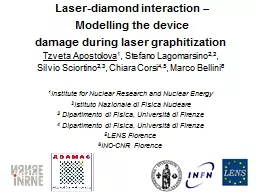

Modelling the device damage during laser graphitization Tzveta Apostolova 1 Stefano Lagomarsino 23 Silvio Sciortino 23 Chiara Corsi 45 Marco Bellini 6 1 Institute ID: 619161
Download Presentation The PPT/PDF document "Laser-diamond interaction" is the property of its rightful owner. Permission is granted to download and print the materials on this web site for personal, non-commercial use only, and to display it on your personal computer provided you do not modify the materials and that you retain all copyright notices contained in the materials. By downloading content from our website, you accept the terms of this agreement.
Slide1
Laser-diamond interaction – Modelling the devicedamage during laser graphitizationTzveta Apostolova1, Stefano Lagomarsino2,3,Silvio Sciortino2,3, Chiara Corsi4,5, Marco Bellini61Institute for Nuclear Research and Nuclear Energy 2Istituto Nazionale di Fisica Nucleare3 Dipartimento di Fisica, Università di Firenze4 Dipartimento di Fisica, Università di Firenze5LENS Florence6INO-CNR FlorenceSlide2
MotivationLaser engineering of diamond for writing conductive paths is an important subject of research for its application in radiation detection (3D detectors)[1,2]. [1] S. Lagomarsino et al Appl. Phys. Lett. 103, 233507 (2013)[2] S. Lagomarsino , et al Diamond & Related Materials 43 (2014) 23–28A deep insight of the process of laser graphitization of diamond is critical to tune at best the laser parameters and obtain low resistivity channels with minimum damage of the surrounding diamond lattice.Simulate ultra-short laser-induced electronic excitation, absorption, and the subsequent relaxation processes in CVD monocrystalline diamond and compare to the results of experiment.Slide3
+
+
+
-
-
-
-
-
-
+
+
+
Lowering
charge trapping probability in the bulk
Thus: increasing collection efficiency
Since their very introduction (1997), 3D achitectures for silicon was intended to solve problems of radiation hardness in silicon
detectors.
Why a 3D architecture for diamond trackers?
(
Nucl
. Instr. and Meth. A 395 pp 328-343 (1997)
)Slide4
Since 2009, a simple 3D pulsed laser technique has been made avalilable for microfabrication of 3D graphitic structures in the bulk Diamond (for optical applications)T.V. Kononenko et al., Femtosecond laser microstructuring in the bulk of diamond, Diamond and Relat. Mater. 18 (2009) 196–199
How it is made
T
his technique has been used by the collaborators to make conductive electrodes for 3D detectors.Slide5
msmA
500 V
Our experimental approach
:
The
transient current technique (TCT) is
used
to
measure laser induced current transients.Slide6
Our theoretical approach: Theoretical modeling (Quantum kinetic formalism based on a Boltzmann-type equation
including photo-excitation, free-carrier absorption, impact ionization, Auger recombination of electron-hole plasma, thermal exchange with the
lattice is performed.
The transient conduction electron distribution functions, electron densities photo-generated and the average electron energies during the pumping fs-laser pulses are evaluated and damage criteria are given.Slide7
Original picture by S.K. Sundaram, Nature Materials 1 (4) 217-224 (2002) and edited for additional relevant processes
Timescales
of
various electron and lattice processes in laser-excited solids.
Inverse bremsstrahlung
Exciton formation/ non-radiative exciton decaySlide8
Mechanisms of absorption and deposition of energy and response of the material.
PI
IB
II
E-E
E-PHN
XD
AR
Original picture by S.K. Sundaram, Nature Materials
1
(4) 217-224 (2002) eddited for the relevant processes
XFSlide9
Laser radiation
electron
hole
Conduction band
Valence band
Forbidden band
CVD diamond
Laser -PI, MPI
IB, II, E-E
AR, XF, XD,E-PHN
Coupling to lattice
QM – Power density
Rate equations
PI Slide10
Boltzmann type scattering equation
Huang,
Apostolova
…
PRB 71, 045204, 2005Slide11
L.V. Keldysh, JETP 20, 1965, Apostolova et al in press NIMA, 2014, Otobe et al, PHYSICAL REVIEW B 77, 165104, 2008Photo-ionization-Keldysh approachSlide12
J. Zeller, et al, in: G.J. Exarhos, A.H. Guenther, N. Kaiser, K.L. Lewis, M.J. Soileau, C.J. Stolz (Eds.), 2003: pp. 515–526. Exiton formation and decay Slide13
Huang,
Apostolova
…
PRB 71, 045204,
2005,
B. K. Ridley, Quantum Processes in Semiconductors (Clarendon, 1999)
intravalley
acoustic phonon
intervalley
phonon Slide14
Apostolova
et al, in press, NIMA, 2014
Electron-electron scattering
Impact ionizationSlide15
A
- auger
recombination time (inversely proportional to
n
2
)
r
- recombination
time for processes in which energy is directly released to the
lattice
e-
ph
-
electron-phonon
energy relaxation
time
k
th,e
- plasma
thermal
conductivity
D
a
-
ambipolar
diffusivity, dependent both on the plasma temperature
-
E
/(3kBn) and on the lattice temperature TDa -
Slide16
Results for CVD diamondSlide17
Results for CVD diamondSlide18
Results for CVD diamondSlide19
Results for CVD diamondSlide20
Results for CVD diamondSlide21
Results for CVD diamondSlide22
Results for CVD diamondSlide23
Log Qmeas. (a.u.)Log ncalc.(a.u.)
measurementsmodel
JSlide24
Optical damage
Electrical damage
Structural damage
Classification of laser damage to semiconductors and dielectricsSlide25
ConclusionsA theoretical simulation accounting for the excitation processes in the bulk of diamond, induced by femtosecond laser irradiation has been carried out. The input parameters correspond to the experimental conditions of fabrication of graphitic conductive channels, from low field intensity to below about the threshold of laser graphitization. The model is in very good qualitative agreement with the experimental measurements of transient currents excited by the laser beam focused inside the diamond bulk. Slide26
Conclusions
An evaluation of the lattice temperature confirms the non-thermal nature of the graphitization process. A deeper understanding of the process will be useful to predict the outcome at different process parameters (wavelength, intensity, pulse width, repetition rate) and to plan useful improvements of the technology. Slide27
OutlookMore processes will be added to the calculation such as electron-electron scattering, electron-phonon scattering, impact ionization as well as non-radiative recombination for indirect band-gap materials.The calculation will be extended to times after the end of the applied laser irradiation, i.e., tens and hundreds of picoseconds. Slide28
n (cm-3)E (J)Slide29
Our experimental approach:The transient current technique (TCT) is used to measure laser induced current transients.